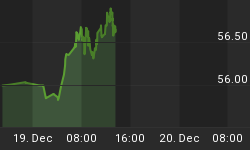While the broad market fell last week gold rallied hard. For the past few weeks we've seen gold and gold stocks held down as various US Federal Reserve officials have talked more hawkish about inflation and market analysts have predicted future rate hikes from the Fed later this year. As I wrote last week though I do not believe we'll see the Fed raise rates this year, because I'm expecting the bear market in stocks and further banking problems to force them to stay on hold. Once this becomes clear to the market - which I think will happen in the Fall - I'm expecting we'll see some real fireworks - with steep losses in stocks and the dollar - which will lead to an explosion in the price of gold.
It is noteworthy that while the market suffered losses on Thursday and Friday gold stocks rallied hard. This is proof that a drop in the broad US stock market doesn't necessarily translate into a drop in gold or mining stocks.

Let's step back for a few minutes and take a look at a ten year chart of gold stocks. There are two things I want you to notice. First large rallies in gold stocks have been preceded by the 200-day bollinger bands for the HUI and XAU gold stock indices coming together. Each of the last four times that this has happened in the past ten years gold stocks rallied hard for the next several months - and sometimes for a whole year. What causes the 200-day bollinger bands to come together are long periods of low volatility in gold stocks. They simply traded in a range for months and then broke out to the upside.
At the same time gold stocks have a tendency to lead the metal. As a result the XAU/gold and HUI/gold relative strength ratios have been important indicators to follow to determine the trend in gold stocks. During gold stocks corrections or long periods of consolidation these ratios have traded in downtrends. One can draw simple downtrend resistance lines on this ratio during such times. The start of large rallies in mining stocks have coincided with this ratio breaking above these relative strength downtrend resistance lines.
Gold stocks most recently put in a top that coincided with the last major low in the S&P 500. As the Fed bailed out Bear Stearns by giving billions of dollars to JP Morgan so that it could take over its worthless "Level 3" mortgage debt, gold stocks peaked. They then fell hard into May and have since gone sideways. The whole time from March to today should be seen as part of a 4-6 month long summer consolidation period. I still believe that gold stocks are still in a consolidation pattern, but are likely to break out of it by the end of August and begin a rally that will last into the end of the year. This projection matches the historical seasonal pattern of gold stocks consolidating in the summer and then having their best months from late August through March.

On Thursday the HUI broke above its downtrend line that connects its March, May, and June highs. The next resistance area for the HUI is in the 467-490 area. This is the area between its upper 200-day bollinger band and the 2/3's retracement level of the March high and May low. I personally have 470 as a target.
It is logical to expect some sort of pullback in this resistance zone to take place for gold stocks. They should then consolidate for several weeks and then breakout. If they do indeed breakout they will rally through their upper 200-day bollinger band and begin a rally that should last into the end of the year.
This setup would lead to about another 4-6 weeks of consolidation and cause the 200-day bollinger bands to narrow even further. We will have to see how things are situated in August, but the possibility of a truly bullish setup evolving is highly likely. I'll keep my eyes on this for you over the next few weeks.
This article is an excerpt from a WallStreetWindow subscription article. To receive my stock picks and all future articles just click here.















